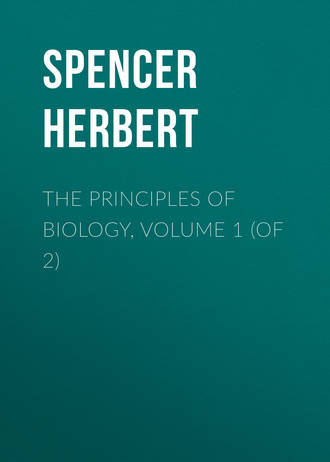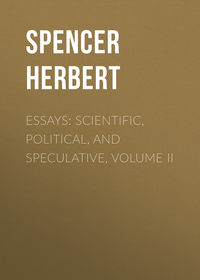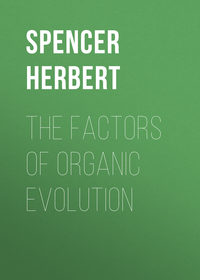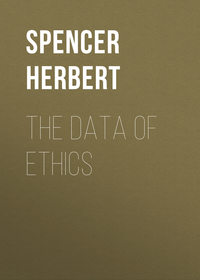 полная версия
полная версияThe Principles of Biology, Volume 1 (of 2)
It is, however, the nitrogenous constituents of living tissues, that display most markedly those characteristics of which we have been tracing the growth. Albumen, fibrin, casein, and their allies, are bodies in which that molecular mobility exhibited by three of their components in so high a degree is reduced to a minimum. These substances are known only in the solid state. That is to say, when deprived of the water usually mixed with them, they do not admit of fusion, much less of volatilization. To which add, that they have not even that molecular mobility which solution in water implies; since, though they form viscid mixtures with water, they do not dissolve in the same perfect way as do inorganic compounds. The chemical characteristics of these substances are instability and inertness carried to the extreme. How rapidly albumenoid matters decompose under ordinary conditions, is daily seen: the difficulty of every housewife being to prevent them from decomposing. It is true that when desiccated and kept from contact with air, they may be preserved unchanged for long periods; but the fact that they can be only thus preserved, proves their great instability. It is true, also, that these most complex nitrogenous principles are not absolutely inert, since they enter into combinations with some bases; but their unions are very feeble.
It should be noted, too, of these bodies, that though they exhibit in the lowest degree that kind of molecular mobility which implies facile vibration of the molecules as wholes, they exhibit in high degrees that kind of molecular mobility resulting in isomerism, which implies permanent changes in the positions of adjacent atoms with respect to each other. Each of them has a soluble and an insoluble form. In some cases there are indications of more than two such forms. And it appears that their metamorphoses take place under very slight changes of conditions.
In these most unstable and inert organic compounds, we find that the molecular complexity reaches a maximum: not only since the four chief organic elements are here united with small proportions of sulphur and sometimes phosphorus; but also since they are united in high multiples. The peculiarity which we found characterized even diatomic compounds of the organic elements, that their molecules are formed not of single equivalents of each component, but of two, three, four, and more equivalents, is carried to the greatest extreme in these compounds, which take the leading part in organic actions. According to Lieberkühn, the formula of albumen is C72H112SN18O22. That is to say, with the sulphur there are united seventy-two atoms of carbon, one hundred and twelve of hydrogen, eighteen of nitrogen, and twenty-two of oxygen: the molecule being thus made up of more than two hundred ultimate atoms.
§ 5. Did space permit, it would be useful here to consider in detail the interpretations that may be given of the peculiarities we have been tracing: bringing to their solution, the general mechanical principles which are now found to hold true of molecules as of masses. But it must suffice briefly to indicate the conclusions which such an inquiry promises to bring out.
Proceeding on these principles, it may be argued that the molecular mobility of a substance must depend partly on the inertia of its molecules; partly on the intensity of their mutual polarities; partly on their mutual pressures, as determined by the density of their aggregation; and (where the molecules are compound) partly on the molecular mobilities of their component molecules. Whence it is to be inferred that any three of these remaining constant, the molecular mobility will vary as the fourth. Other things equal, therefore, the molecular mobility of molecules must decrease as their masses increase; and so there must result that progression we have traced, from the high molecular mobility of the uncombined organic elements, to the low molecular mobility of those large-moleculed substances into which they are ultimately compounded.
Applying to molecules the mechanical law which holds of masses, that since inertia and gravity increase as the cubes of the dimensions while cohesion increases as their squares, the self-sustaining power of a body becomes relatively smaller as its bulk becomes greater; it might be argued that these large, aggregate molecules which constitute organic substances, are mechanically weak – are less able than simpler molecules to bear, without alteration, the forces falling on them. That very massiveness which renders them less mobile, enables the physical forces acting on them more readily to change the relative positions of their component atoms; and so to produce what we know as re-arrangements and decompositions.
Further, it seems a not improbable conclusion, that this formation of large aggregates of elementary atoms and resulting diminution of self-sustaining power, must be accompanied by a decrease of those dimensional contrasts to which polarity is ascribable. A sphere is the figure of equilibrium which any aggregate of units tends to assume, under the influence of simple mutual attraction. Where the number of units is small and their mutual polarities are decided, this proclivity towards spherical grouping will be overcome by the tendency towards some more special form, determined by their mutual polarities. But it is manifest that in proportion as an aggregate molecule becomes larger, the effects of simple mutual attraction must become relatively greater; and so must tend to mask the effects of polar attraction. There will consequently be apt to result in highly compound molecules like these organic ones, containing hundreds of elementary atoms, such approximation to the spherical form as must involve a less distinct polarity than in simpler molecules. If this inference be correct, it supplies us with an explanation both of the chemical inertness of these most complex organic substances, and of their inability to crystallize.
§ 6. Here we are naturally introduced to another aspect of our subject – an aspect of great interest. Professor Graham has published a series of important researches, which promise to throw much light on the constitution and changes of organic matter. He shows that solid substances exist under two forms of aggregation – the colloid or jelly-like, and the crystalloid or crystal-like. Examples of the last are too familiar to need specifying. Of the first may be named such instances as "hydrated silicic acid, hydrated alumina, and other metallic peroxides of the aluminous class, when they exist in the soluble form; with starch, dextrine and the gums, caramel, tannin, albumen, gelatine, vegetable and animal extractive matters." Describing the properties of colloids, Professor Graham says: – "Although often largely soluble in water, they are held in solution by a most feeble force. They appear singularly inert in the capacity of acids and bases, and in all the ordinary chemical relations." * * * "Although chemically inert in the ordinary sense, colloids possess a compensating activity of their own arising out of their physical properties. While the rigidity of the crystalline structure shuts out external impressions, the softness of the gelatinous colloid partakes of fluidity, and enables the colloid to become a medium of liquid diffusion, like water itself." * * * "Hence a wide sensibility on the part of colloids to external agents. Another and eminently characteristic quality of colloids is their mutability." * * * "The solution of hydrated silicic acid, for instance, is easily obtained in a state of purity, but it cannot be preserved. It may remain fluid for days or weeks in a sealed tube, but is sure to gelatinize and become insoluble at last. Nor does the change of this colloid appear to stop at that point; for the mineral forms of silicic acid, deposited from water, such as flint, are often found to have passed, during the geological ages of their existence, from the vitreous or colloidal into the crystalline condition (H. Rose). The colloid is, in fact, a dynamical state of matter, the crystalloidal being the statical condition. The colloid possesses energia. It may be looked upon as the primary source of the force appearing in the phenomena of vitality. To the gradual manner in which colloidal changes take place (for they always demand time as an element) may the characteristic protraction of chemico-organic changes also be referred."
The class of colloids includes not only all those most complex nitrogenous compounds characteristic of organic tissues, and sundry of the carbo-hydrates found along with them; but, significantly enough, it includes several of those substances classed as inorganic, which enter into organized structures. Thus silica, which is a component of many plants, and constitutes the spicules of sponges as well as the shells of many foraminifera and infusoria, has a colloid, as well as a crystalloid, condition. A solution of hydrated silicic acid passes in the course of a few days into a solid jelly that is no longer soluble in water; and it may be suddenly thus coagulated by a minute portion of an alkaline carbonate, as well as by gelatine, alumina, and peroxide of iron. This last-named substance, too – peroxide of iron – which is an ingredient in the blood of mammals and composes the shells of certain Protozoa, has a colloid condition. "Water containing about one per cent. of hydrated peroxide of iron in solution, has the dark red colour of venous blood." * * * "The red solution is coagulated in the cold by traces of sulphuric acid, alkalies, alkaline carbonates, sulphates, and neutral salts in general." * * * "The coagulum is a deep red-coloured jelly, resembling the clot of blood, but more transparent. Indeed, the coagulum of this colloid is highly suggestive of that of blood, from the feeble agencies which suffice to effect the change in question, as well as from the appearance of the product." The jelly thus formed soon becomes, like the last, insoluble in water. Lime also, which is so important a mineral element in living bodies, animal and vegetal, enters into a compound belonging to this class. "The well-known solution of lime in sugar forms a solid coagulum when heated. It is probably, at a high temperature, entirely colloidal."
Generalizing some of the facts which he gives, Professor Graham says: – "The equivalent of a colloid appears to be always high, although the ratio between the elements of the substance may be simple. Gummic acid, for instance, may be represented by C12H22O11; but, judging from the small proportions of lime and potash which suffice to neutralize this acid, the true numbers of its formula must be several times greater. It is difficult to avoid associating the inertness of colloids with their high equivalents, particularly where the high number appears to be attained by the repetition of a small number. The inquiry suggests itself whether the colloid molecule may not be constituted by the grouping together of a number of smaller crystalloid molecules, and whether the basis of colloidality may not really be this composite character of the molecule."
§ 7. A further contrast between colloids and crystalloids is equally significant in its relations to vital phenomena. Professor Graham points out that the marked differences in volatility displayed by different bodies, are paralleled by differences in the rates of diffusion of different bodies through liquids. As alcohol and ether at ordinary temperatures, and various other substances at higher temperatures, diffuse themselves in a gaseous form through the air; so, a substance in aqueous solution, when placed in contact with a mass of water (in such way as to avoid mixture by circulating currents) diffuses itself through this mass of water. And just as there are various degrees of rapidity in evaporation, so there are various degrees of rapidity in diffusion: "the range also in the degree of diffusive mobility exhibited by different substances appears to be as wide as the scale of vapour-tensions." This parallelism is what might have been looked for; since the tendency to assume a gaseous state, and the tendency to spread in solution through a liquid, are both consequences of molecular mobility. It also turns out, as was to be expected, that diffusibility, like volatility, has, other things equal, a relation to molecular weight – other things equal, we must say, because molecular mobility must, as pointed out in § 5, be affected by other properties of atoms, besides their inertia. Thus the substance most rapidly diffused of any on which Professor Graham experimented, was hydrochloric acid – a compound which is of low molecular weight, is gaseous save under a pressure of forty atmospheres, and ordinarily exists as a liquid, only in combination with water. Again, "hydrate of potash may be said to possess double the velocity of diffusion of sulphate of potash, and sulphate of potash again double the velocity of sugar, alcohol, and sulphate of magnesia," – differences which have a general correspondence with differences in the massiveness of their molecules.
But the fact of chief interest to us here, is that the relatively small-moleculed crystalloids have immensely greater diffusive power than the relatively large-moleculed colloids. Among the crystalloids themselves there are marked differences of diffusibility; and among the colloids themselves there are parallel differences, though less marked ones. But these differences are small compared with that between the diffusibility of the crystalloids as a class, and the diffusibility of the colloids as a class. Hydrochloric acid is seven times as diffusible as sulphate of magnesia; but it is fifty times as diffusible as albumen, and a hundred times as diffusible as caramel.
These differences of diffusibility manifest themselves with nearly equal distinctness, when a permeable septum is placed between the solution and the water. The result is that when a solution contains substances of different diffusibilities, the process of dialysis, as Professor Graham calls it, becomes a means of separating the mixed substances: especially when such mixed substances are partly crystalloids and partly colloids. The bearing of this fact on the interpretation of organic processes will be obvious. Still more obvious will its bearing be, on joining with it the remarkable fact that while crystalloids can diffuse themselves through colloids nearly as rapidly as through water, colloids can scarcely diffuse themselves at all through other colloids. From a mass of jelly containing salt, into an adjoining mass of jelly containing no salt, the salt spread more in eight days than it spread through water in seven days; while the spread of "caramel through the jelly appeared scarcely to have begun after eight days had elapsed." So that we must regard the colloidal compounds of which organisms are built, as having, by their physical nature, the ability to separate colloids from crystalloids, and to let the crystalloids pass through them with scarcely any resistance.
One other result of these researches on the relative diffusibilities of different substances has a meaning for us. Professor Graham finds that not only does there take place, by dialysis, a separation of mixed substances which are unlike in their molecular mobilities; but also that combined substances between which the affinities are feeble, will separate on the dialyzer, if their molecular mobilities are strongly contrasted. Speaking of the hydrochloride of peroxide of iron, he says, "such a compound possesses an element of instability in the extremely unequal diffusibility of its constituents;" and he points out that when dialyzed, the hydrochloric acid gradually diffuses away, leaving the colloidal peroxide of iron behind. Similarly, he remarks of the peracetate of iron, that it "may be made a source of soluble peroxide, as the salt referred to is itself decomposed to a great extent by diffusion on the dialyzer." Now this tendency to separate displayed by substances which differ widely in their molecular mobilities, though usually so far antagonized by their affinities as not to produce spontaneous decomposition, must, in all cases, induce a certain readiness to change which would not else exist. The unequal mobilities of the combined atoms must give disturbing forces a greater power to work transformations than they would otherwise have. Hence the probable significance of a fact named at the outset, that while three of the chief organic elements have the greatest atomic mobilities of any elements known, the fourth, carbon, has the least atomic mobility of known elements. Though, in its simple compounds, the affinities of carbon for the rest are strong enough to prevent the effects of this great difference from clearly showing themselves; yet there seems reason to think that in those complex compounds composing organic bodies – compounds in which there are various cross affinities leading to a state of chemical tension – this extreme difference in the molecular mobilities must be an important aid to molecular re-arrangements. In short, we are here led by concrete evidence to the conclusion which we before drew from first principles, that this great unlikeness among the combined units must facilitate differentiations.
§ 8. A portion of organic matter in a state to exhibit those phenomena which the biologist deals with, is, however, something far more complex than the separate organic matters we have been studying; since a portion of organic matter in its integrity, contains several of these.
In the first place no one of those colloids which make up the mass of a living body, appears capable of carrying on vital changes by itself: it is always associated with other colloids. A portion of animal-tissue, however minute, almost always contains more than one form of protein-substance: different chemical modifications of albumen and gelatine are present together, as well as, probably, a soluble and insoluble modification of each; and there is usually more or less of fatty matter. In a single vegetal cell, the minute quantity of nitrogenous colloid present, is imbedded in colloids of the non-nitrogenous class. And the microscope makes it at once manifest, that even the smallest and simplest organic forms are not absolutely homogeneous.
Further, we have to contemplate organic tissue, formed of mingled colloids in both soluble and insoluble states, as permeated throughout by crystalloids. Some of these crystalloids, as oxygen,5 water, and perhaps certain salts, are agents of decomposition; some, as the saccharine and fatty matters, are probably materials for decomposition; and some, as carbonic acid, water, urea, kreatine, and kreatinine, are products of decomposition. Into the mass of mingled colloids, mostly insoluble and where soluble of very low molecular mobility or diffusive power, we have constantly passing, crystalloids of high molecular mobility or diffusive power, that are capable of decomposing these complex colloids, or of facilitating decompositions otherwise caused; and from these complex colloids, when decomposed, there result other crystalloids (the two chief ones extremely simple and mobile, and the rest comparatively so) which diffuse away as rapidly as they are formed.
And now we may clearly see the necessity for that peculiar composition which we find in organic matter. On the one hand, were it not for the extreme molecular mobility possessed by three out of the four of its chief elements; and were it not for the consequently high molecular mobility of their simpler compounds; there could not be this quick escape of the waste products of organic action; and there could not be that continuously active change of matter which vitality implies. On the other hand, were it not for the union of these extremely mobile elements into immensely complex compounds, having relatively vast molecules which are made comparatively immobile by their inertia, there could not result that mechanical fixity which prevents the components of living tissue from diffusing away along with the effete matters produced by decomposition.
§ 8a. Let us not omit here to note the ways in which the genesis of these traits distinguishing organic matter conforms to the laws of evolution as expressed in its general formula.
In pursuance of the belief now widely entertained by chemists that the so-called elements are not elements, but are composed of simpler matters and probably of one ultimate form of matter (for which the name "protyle" has been suggested by Sir W. Crookes), it is to be concluded that the formation of the elements, in common with the formation of all those compounds of them which Nature presents, took place in the course of Cosmic Evolution. Various reasons for this inference the reader will find set forth in the Addenda to an essay on "The Nebular Hypothesis" (see Essays, vol. I, p. 155). On tracing out the process of compounding and re-compounding by which, hypothetically, the elements themselves and afterwards their compounds and re-compounds have arisen, certain cardinal facts become manifest.
1. Considered as masses, the units of the elements are the smallest, though larger than the units of the primordial matter. Later than these, since they are composed of them, and since they cannot exist at temperatures so high as those at which the elements can exist, come the diatomic compounds – oxides, chlorides, and the rest – necessarily larger in their molecules. Above these in massiveness come the molecules of the multitudinous salts and kindred bodies. When associated, as these commonly are, with molecules of water, there again results in each case increase of mass; and unable as they are to bear such high temperatures, these molecules are necessarily later in origin than those of the anhydrous diatomic compounds. Within the general class of triatomic compounds, more composite still, come the carbohydrates, which, being able to unite in multiples, form still larger molecules than other triatomic compounds. Decomposing as they do at relatively low temperatures, these are still more recent in the course of chemical evolution; and with the genesis of them the way is prepared for the genesis of organic matter strictly so called. This includes the various forms of protein-substance, containing four chief elements with two minor ones, and having relatively vast molecules. Unstable as these are in presence of heat and surrounding affinities, they became possible only at a late stage in the genesis of the Earth. Here, then, in that chemical evolution which preceded the evolution of life, we see displayed that process of integration which is the primary trait of evolution at large.
2. Along with increasing integration has gone progress in heterogeneity. The elements, regarding them as compound, are severally more heterogeneous than "protyle." Diatomic molecules are more heterogeneous than these elements; triatomic more heterogeneous than diatomic; and the molecules containing four elements more heterogeneous than those containing three: the most heterogeneous of them being the proteids, which contain two other elements. The hydrated forms of all these compounds are more heterogeneous than are the anhydrous forms. And most heterogeneous of all are the molecules which, besides containing three, four, or more elements, also exhibit the isomerism and polymerism which imply unions in multiples.
3. This formation of molecules more and more heterogeneous during terrestrial evolution, has been accompanied by increasing heterogeneity in the aggregate of compounds of each kind, as well as an increasing number of kinds; and this increasing heterogeneity is exemplified in an extreme degree in the compounds, non-nitrogenous and nitrogenous, out of which organisms are built. So that the classes, orders, genera, and species of chemical substances, gradually increasing as the Earth has assumed its present form, increased in a transcendent degree during that stage which preceded the origin of life.
§ 9. Returning now from these partially-parenthetic observations, and summing up the contents of the preceding pages, we have to remark that in the substances of which organisms are composed, the conditions necessary to that re-distribution of Matter and Motion which constitutes Evolution, are fulfilled in a far higher degree than at first appears.
The mutual affinities of the chief organic elements are not active within the limits of those temperatures at which organic actions take place; and one of these elements is especially characterized by its chemical indifference. The compounds formed by these elements in ascending grades of complexity, become progressively less stable. And those most complex compounds into which all these four elements enter, together with small proportions of two other elements which very readily oxidize, have an instability so great that decomposition ensues under ordinary atmospheric conditions.









